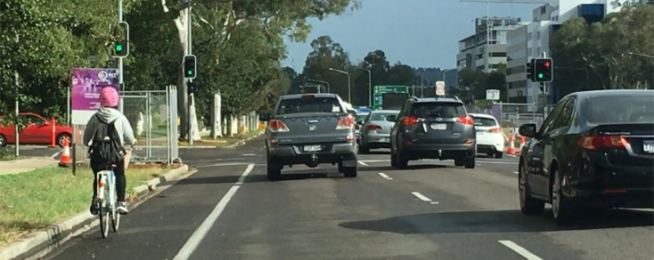A new study on bike lanes in the nation's capital has found that simple bike lanes on main arterial roads lead drivers to pass bike riders closer than on roads without bike lanes.
Researchers from the University of Adelaide concluded that additional measures, such as separated bike riding infrastructure, may be required to provide a sufficient level of safety for bike riders on 'trunk' roads, or main roads used for long distance travel in the ACT.
The study collected data from 23 cyclists over a 4-week period where 16,000 passing events were detected.
Trunk roads in ACT include the Federal and Barton Highways, Northbourne Avenue, Commonwealth Avenue, part of State Circle and part of Canberra Avenue.
Dr Jamie McKenzie from the University of Adelaide said: "The aim of the study was to collect data on cyclist-vehicle passing distances within the ACT in a naturalistic way. That is, to record the experiences of typical cyclists riding their typical journeys."
"The majority of passing events occurred at a safe and lawful distance, but close passes did occur, and a few were extremely close. The results were analysed by exploring how factors such as speed limit, road type, and bike lanes affected passing distance"
Drivers were generally compliant with ACT minimum passing distances laws — requiring 1 metre when overtakinga cyclist under 60km/h and 1.5 metres required if a driver is overtaking at more than 60km/h — with 12.3 per cent of passes found to be too close.
While bike lanes were generally associated with an increase in passing distance, passing distances were found to be six centimeters closer on average on high-speed roads with bike lanes than on similar high-speed roads without bike lanes.
This lead the study to conclude that "further research is warranted to gain more thorough understanding of why there is reduced effectiveness for bike lanes on these roads."
The study effectively highlights that speed limit, bike lane, and road classification all affect passing distance and probability of non-compliant pass.
Minimum passing laws were introduced in the ACT in 2015 initially on a trial basis, and permanently implemented in 2018.
Pedal Power ACT Chief Executive Ian Ross was quoted in The Canberra Times: "The University of Adelaide study highlights the need for a safe, direct cycleway network that is adequately separated from both vehicles and pedestrians."
As a new city that has been famously designed for optimized car transport, Canberra has a network of wide, direct and well designed arterial roads with minimal crossing and interruptions.
In contrast, "the ACT's existing shared path network is often meandering, built to the narrowest standard width, requires frequent stops at crossings, and is used by a growing number of varied path users who move at different speeds," says Mr Ross.
Pointing to the logical conclusion: The ACT has the opportunity to significantly increase active travel participation rates and achieve it's zero net-emissions target by installing adequate separated cycleways along the main arterial road network and direct, connected and separated cycleways between town centres.
Become our friend
Find out more about Bicycle Network and support us in making it easier for people to ride bikes.


